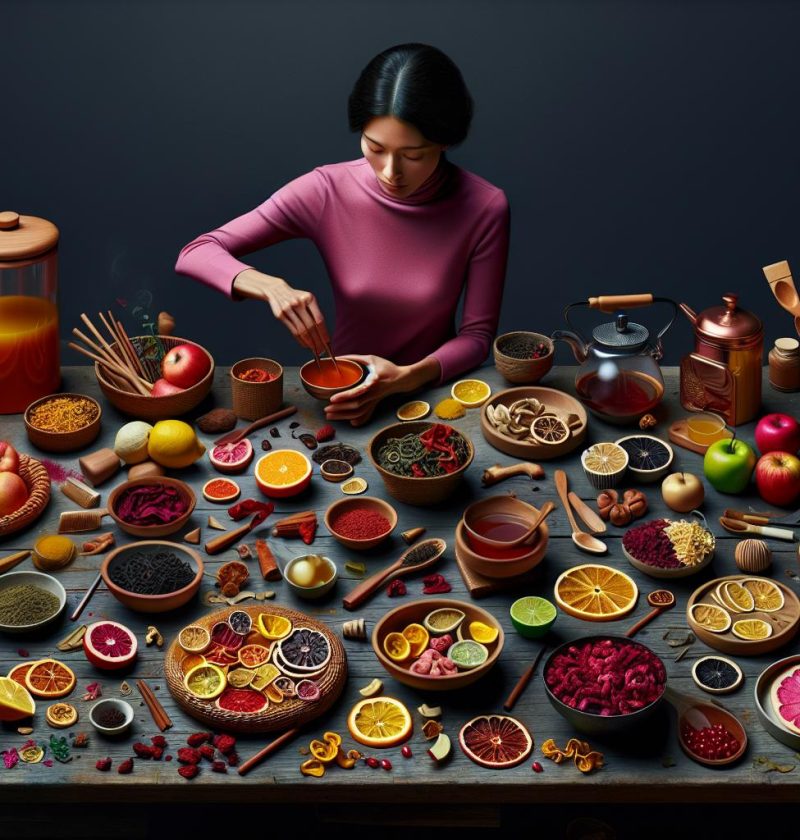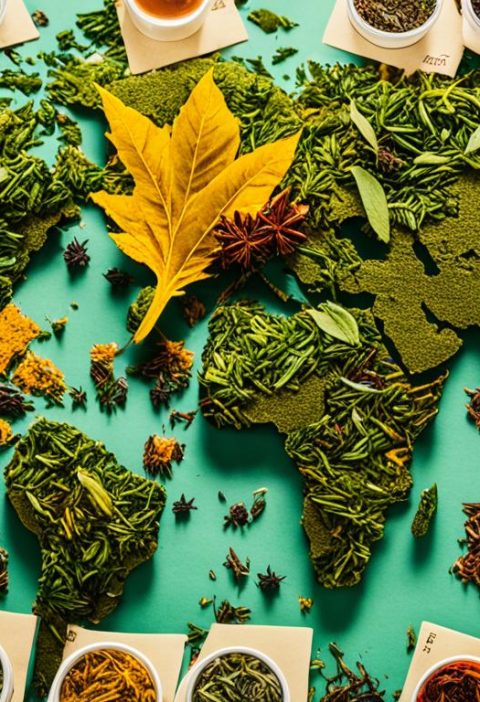When it comes to crafting our own tea blends, the possibilities are endless. From soothing floral notes to invigorating spices, the world of tea ingredients is a treasure trove waiting to be explored. In our quest for the perfect cup, we delve into the realm of unique DIY tea blend ingredients that will elevate our tea-drinking experience to new heights.
With a dash of creativity and a sprinkle of curiosity, we uncover exotic botanicals, rare herbs, and aromatic fruits that add a touch of magic to our homemade tea creations. Join us on this flavorful journey as we discover the art of blending unique ingredients to brew teas that tantalize the taste buds and soothe the soul. Let’s unlock the secrets of crafting one-of-a-kind tea blends that reflect our individuality and passion for the perfect cup of tea.
Benefits of DIY Tea Blending
When it comes to DIY tea blending, there are numerous advantages to exploring this craft. Whether you are a beginner looking to dip your toes into the world of custom teas or an expert seeking to refine your skills further, creating your own blends can be a rewarding and creative process. Let’s delve into the benefits based on different experience levels:
For Beginners: Getting Started on Your Tea Blending Journey
- Introduction to Flavor Profiles: Begin by familiarizing yourself with various tea types and flavor profiles to understand how different ingredients complement each other.
- Experimentation Opportunity: DIY blending allows you to experiment with personal preferences, ensuring that every cup suits your taste.
- Cost-Effective: Creating your own blends can be more cost-effective in the long run compared to purchasing pre-made teas.
- Health Benefits: Customizing blends lets you incorporate beneficial herbs and botanicals tailored to your well-being.
For Intermediate Tea Enthusiasts: Deepening Your Tea Blending Skills
- Enhanced Creativity: Intermediate blenders can explore unique combinations and tweak existing recipes to create signature blends.
- Aromatic Experience: Delve into creating teas with aromatic herbs and spices to enhance the sensory experience.
- Catering to Personal Preferences: Tailor blends to suit specific moods, occasions, or health goals for a truly personalized tea experience.
- Refinement and Precision: Advanced blenders can focus on refining ratios and understanding the nuances of ingredient interactions for sophisticated flavor profiles.
- Showcasing Expertise: Create intricate blends that showcase your expertise and cater to specific palates or themes.
- Potential for Business Ventures: For those looking to turn their passion into a business, advanced tea blending opens doors to entrepreneurial opportunities.
With these benefits in mind, diving into the world of DIY tea blending can be an exciting journey of creativity and self-discovery. Experiment, explore, and savor the delightful process of crafting your own unique tea blends tailored to your tastes and preferences.
Exploring Exotic Botanicals

When it comes to creating unique DIY tea blends, one of the most exciting aspects is Exploring Exotic Botanicals. These rare and intriguing ingredients can add depth, complexity, and a touch of the extraordinary to your blends. Whether you’re a beginner looking to expand your flavor horizons or an expert seeking to push the boundaries of tea blending, incorporating exotic botanicals can truly elevate your creations.
For Beginners: Diving into Uncharted Territory
For those just starting on their DIY tea blending journey, experimenting with exotic botanicals can be a fun and rewarding experience. Here are some tips to get you started:
- Start small by trying one new botanical at a time to understand its flavor profile.
- Research how each botanical is traditionally used in teas to get a sense of its potential.
- Some beginner-friendly exotic botanicals to consider are hibiscus flowers, lemongrass, or dried rose petals.
- Remember to balance the flavors of your blend to ensure a harmonious taste experience.
For Intermediate Blenders: Refining Your Craft
If you’ve already dabbled in DIY tea blending and want to take it up a notch, incorporating exotic botanicals can be a game-changer. Here are some suggestions for intermediate blenders:
- Experiment with infusing spices like cardamom pods, star anise, or vanilla beans for added depth.
- Consider dried fruits such as goji berries or dried mango to introduce a hint of sweetness.
- Play around with combining multiple botanicals to create unique flavor profiles.
- Don’t be afraid to trust your palate and customize the blend to suit your preferences.
- Source rare and unusual botanicals like blue butterfly pea flowers, spikenard root, or heather flowers for a truly distinct blend.
- Experiment with layering flavors by incorporating botanicals with different profiles and aromas.
- Consider fermenting or aging certain botanicals to develop complex and nuanced flavors over time.
- Embrace innovation by blending traditional tea ingredients with avant-garde
Uncovering Rare Herbs
When it comes to creating unique DIY tea blends, Uncovering Rare Herbs can truly elevate your blending game. These elusive botanicals can add depth, complexity, and a touch of mystery to your teas. Whether you’re a novice looking to delve into the world of rare herbs or an experienced blender seeking new inspirations, exploring these ingredients can unlock a whole new realm of creativity.
For Beginners:
As you embark on your journey to incorporate rare herbs into your tea blends, it’s essential to start with some foundational knowledge:
- Research the properties and flavor profiles of different rare herbs.
- Begin experimenting with small quantities to understand how each herb impacts the overall blend.
- Consider starting with more familiar rare herbs like Bergamot or Yuzu to ease into the world of exotic flavors.
For Intermediate Blenders:
If you’ve already dabbled in blending and are ready to level up your creations with rare herbs, here are some tips:
- Explore lesser-known rare herbs such as Butterfly Pea Flower or Szechuan Peppercorn for unique flavor twists.
- Experiment with blending multiple rare herbs to create your signature tea blend with depth and complexity.
- Pay attention to the balance of flavors and aromas to create harmonious blends that delight the senses.
For Advanced Enthusiasts:
For those seasoned blenders who crave a challenge and wish to push the boundaries of tea blending, consider these advanced techniques:
- Source ultra-rare herbs like Blue Tansy or Tulsi Holy Basil for truly distinctive blends.
- Experiment with intricate flavor layering techniques to create teas with evolving tastes from first sip to finish.
- Delve into innovative processes like herbal fermentation to unlock new dimensions of flavor and aroma in your blends.
Embrace the art of Uncovering Rare Herbs in your DIY tea blends to infuse your creations with a touch of magic and exclusivity. The world of botanicals is vast and enchanting, offering endless possibilities for crafting teas that are as unique as they are extraordinary.
Aromatic Fruits for Tea Blends
When it comes to crafting unique DIY tea blends, aromatic fruits offer a splendid avenue for enhancing flavors and aromas. Whether you are a novice or a seasoned tea blender, incorporating these fruits can elevate your creations to new heights. Let’s delve into how different experience levels can make the most of aromatic fruits in their tea blends.
For Beginners: Exploring the Basics
For beginners in the art of tea blending, starting with aromatic fruits can be a delightful introduction to the world of flavor experimentation. Here are some steps to get you started:
- Citrus Zest: Begin with adding a touch of citrus zest from oranges, lemons, or limes to infuse a refreshing note into your tea blend.
- Dried Berries: Experiment with dried berries like cranberries or raspberries for a hint of sweetness and tartness in your tea.
- Apple Slices: Incorporate thin apple slices for a mild, fruity taste that complements various tea bases.
For Intermediate Blenders: Enhancing Complexity
Intermediate blenders looking to enhance the complexity of their tea blends can take a step further by exploring a wider range of aromatic fruits. Here are some recommendations:
- Pomegranate Seeds: Add a burst of flavor and a touch of sophistication with pomegranate seeds in your tea blend.
- Mango Chunks: Infuse tropical vibes into your blend by including mango chunks for a fruity and exotic twist.
- Peach Slices: Incorporate peach slices for a summery aroma that pairs beautifully with black or green tea bases.
For Advanced Enthusiasts: Elevating with Exotic Fruits
For those seeking to push the boundaries of tea blending and create truly unique combinations, experimenting with exotic aromatic fruits is key. Here are some extraordinary choices:
- Passion Fruit Pulp: Intensify the tropical essence in your tea blend with passion fruit pulp for a bold and tangy flavor profile.
- Lychee Flesh: Delight your senses with the floral and sweet notes of lychee flesh, adding a luxurious touch to your tea creation.
- Dragon Fruit Cubes: Opt for dragon fruit cubes to introduce a visually striking element along with a subtly sweet taste to your blend.
Crafting Personalized Tea Blends

Tea blending can be an art form, allowing us to customize and create unique blends that cater to our specific tastes and preferences. Whether you’re just starting or already an experienced blender, there are endless possibilities to explore in crafting personalized tea blends. Here’s how you can elevate your tea blending game at different experience levels:
For Beginners: Mastering the Basics
- Start by selecting a base tea that you enjoy, such as black, green, or herbal.
- Experiment with adding citrus zest for a refreshing twist or dried berries for a burst of sweetness.
- Keep ratios simple at first and taste as you go to find the right balance.
For Intermediate Blenders: Enhancing Your Creations
- Incorporate more complex flavors like apple slices for a touch of crispness or pomegranate seeds for a rich, tart note.
- Consider blending different types of tea together for a layered taste experience.
- Explore using mango chunks or peach slices for a tropical flair in your blends.
- Dive into exotic flavors with passion fruit pulp or lychee flesh to create bold and unique combinations.
- Blend multiple fruits and teas to create intricate flavor profiles.
- Push boundaries with ingredients like dragon fruit cubes for a visually stunning and flavorful blend.
Crafting personalized tea blends is a journey of exploration and creativity. Each level of expertise offers a new opportunity to delve deeper into the world of tea blending and unleash your imagination. Let’s continue to experiment, innovate, and enjoy the art of crafting our very own tea blends tailored to our individual tastes and preferences.
Conclusion
Crafting personalized tea blends is a rewarding journey that offers endless opportunities for exploration and creativity. From experimenting with citrus zest to incorporating exotic flavors like passion fruit pulp and dragon fruit cubes, there’s a blend for every level of expertise. Whether you’re a beginner, intermediate blender, or advanced enthusiast, the world of DIY tea blends is yours to discover. Embrace the art of blending, innovate with unique ingredients, and savor the process of creating teas tailored to your individual taste preferences. Join us on this flavorful adventure and elevate your tea experience with one-of-a-kind blends that reflect your personality and passion for tea.






